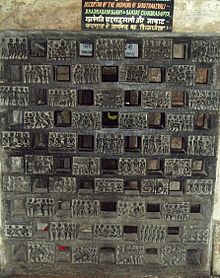|
Bhadrabāhu
Ācārya Bhadrabāhu (c. 367 – c. 298 BC) was, according to both the Śvetāmbara and Digambara sects of Jainism, the last Shruta Kevalin (all knowing by hearsay, that is indirectly) in Jainism.[1][2][3] According to the Digambara tradition, he was the spiritual teacher of Chandragupta Maurya, the founder of the Maurya Empire.[4] According to the Digambara sect of Jainism, there were five Shruta Kevalins in Jainism – Govarddhana Mahamuni, Vishnu, Nandimitra, Aparajita and Bhadrabahu.[5] The Digambaras consider him to have been naked. According to the Śvetāmbara tradition, he was the author of the holy Kalpa Sūtra,[6] which describes the life of Mahavira and other Tirthankaras. It also lists down a Sthaviravali (a succession list of the names of the head of the Jain monastic order according to Śvetāmbaras, starting with Mahavira's Ganadhara (disciple) Sudharmaswami).[7] Śvetāmbaras consider Bhadrabahusuri to be a Sthavirkalpi monk (as described in the Ācārāṅga Sūtra, the Kalpa Sūtra, and the Sthananga Sutra), and thus, white-clad. Śvetāmbaras also consider him to have had been a Shruta Kevalin. Early life Bhadrabahu was born in Pundravardhana (roughly equivalent to modern North Bengal[8]) to a Brahmin family[9] during which time the secondary capital of the Mauryas was Ujjain. When he was seven, Govarddhana Mahamuni predicted that he will be the last Shruta Kevali and took him along for his initial education.[5] According to Śvētāmbara tradition, he lived from 433 BC to 357 BC.[10] Digambara tradition dates him to have died in 365 BC.[11] Natubhai Shah dated him from 322 to 243 BC.[12] Yasobhadra (351-235 BC), leader of the religious order reorganised by Mahavira, had two principle disciples, Sambhutavijaya (347-257 BC) and Bhadrabahu.[12] After his death the religious order was led by Sambhutivijaya. After Sambhutivijaya's death, Bhadrabahu became the head of the monastic order.[12] Digambara biography and explanation of sixteen dreams of Chandragupta The Digambara sect believes that on the night of full moon in the month of Kartik, Chandragupta Maurya (founder and ruler of Maurya Empire) saw sixteen dreams, which were then explained to him by Acharya Bhadrabahu.[13]
 Bhadrabahu was in Nepal for a 12-year penitential vow when the Pataliputra conference took place in 300 BC to put together the Jain canon anew. Bhadrabahu decided the famine would make it harder for monks to survive and migrated with a group of twelve thousand disciples to South India,[15][16] bringing with him Chandragupta, turned Digambar monk.[17][14] According to the inscriptions at Shravanabelgola, Bhadrabahu died after taking the vow of sallekhana (Fast until death).[18] Digambaras believe that Bhadrabahu was the last acharya of the undivided Jain sangha. After him, the Sangha split into two separate teacher-student lineages of monks. Digambara monks belong to the lineage of Acharya Vishakha and Śvetāmbara monks follow the tradition of Acharya Sthulabhadra.[19] However, the theory that the schism occurred at that time has not been historically proven. 10th century Digambara texts state that Sthulabhadra permitted the use loincloth during the 12-year famine, a practice that started the Śvetāmbara order, but is considered as baseless according to followers of the Śvetāmbara sect. Avashyak Bhashya, a 5th-century Śvetāmbara text written by Jinabhadra claims that the Śvetāmbara sect had always existed and that the Digambara sect was created by a rebellious monk named Sivabhuti.[20][21][22] Śvetāmbara biographyAccording to Śvetāmbaras, Bhadrabahusuri was the author of the Kalpa Sūtra,[23] four Chedda sutras, the niryukti collection on ten scriptures,[24] and Uvasaggaharam Stotra.[25][9] The 10 niryuktis authored by him are: -
Śvetāmbaras believe Bhadrabahu's principle disciples were Sthavir Godas, Sthavir Agnidatt, Sthavir Yagnadatt, and Sthavir Somdatt. However, in the Pattavali of Kalpa Sūtra, he is said to have been succeeded by Acharya Sthulabhadrasuri. He is believed to have been a Sthavirkalpi monk and white-clad as Śvetāmbaras believe that the only other way for monks (known as Jinakalpa) or the practice of being a Jinakalpi monk had become extinct after Jambuswami attained nirvana.[26][27] Therefore, Śvetāmbaras hold that he was Sthavirkalpi and thus, white-clad. Śvetāmbaras believe that Bhadrabāhu is the author of the following texts within the official Śvetāmbaras scriptural canon (typically consisting of 45 texts).[28]
LegacyRegarding the inscriptions describing the relation of Bhadrabahu and Chandragupta Maurya, Radha Kumud Mookerji writes,
Bhadrabahu-charitra was written by Ratnanandi of about 1450 AD.[17] See alsoReferencesCitations
Sources
Further reading
External links
Information related to Bhadrabāhu |
|||||||||||||||||||||||||||||||||||||||||||||||||||||||||||||||||||||||||||

